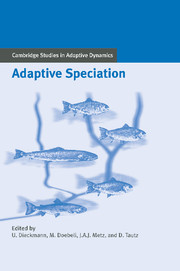Book contents
- Frontmatter
- Contents
- Contributing Authors
- Acknowledgments
- Notational Standards
- 1 Introduction
- 2 Speciation in Historical Perspective
- A Theories of Speciation
- 3 Genetic Theories of Sympatric Speciation
- 4 Adaptive Dynamics of Speciation: Ecological Underpinnings
- 5 Adaptive Dynamics of Speciation: Sexual Populations
- 6 Genetic Theories of Allopatric and Parapatric Speciation
- 7 Adaptive Dynamics of Speciation: Spatial Structure
- B Ecological Mechanisms of Speciation
- C Patterns of Speciation
- References
- Index
3 - Genetic Theories of Sympatric Speciation
Published online by Cambridge University Press: 05 July 2014
- Frontmatter
- Contents
- Contributing Authors
- Acknowledgments
- Notational Standards
- 1 Introduction
- 2 Speciation in Historical Perspective
- A Theories of Speciation
- 3 Genetic Theories of Sympatric Speciation
- 4 Adaptive Dynamics of Speciation: Ecological Underpinnings
- 5 Adaptive Dynamics of Speciation: Sexual Populations
- 6 Genetic Theories of Allopatric and Parapatric Speciation
- 7 Adaptive Dynamics of Speciation: Spatial Structure
- B Ecological Mechanisms of Speciation
- C Patterns of Speciation
- References
- Index
Summary
Introduction
Although populations are usually defined as sympatric if they occur in the same geographic area, application of this definition of sympatry to the classification of genetic mechanisms of population speciation is problematic. Populations that live in the same geographic area, but breed in different habitats or at different times, might be as genetically isolated as populations separated by a mountain range. Consider a one-time colonization of a novel host species by a parasite, with no subsequent gene flow between the parasite population on the novel and usual hosts. This is analogous to a one-time colonization of an isolated island, a classic scenario for allopatric speciation. It does not matter whether or not the parasite populations on the two host species occur in the same geographic area. In contrast, the prospects for and potential mechanisms of speciation would be very different if cross-infection occurred frequently, with a resultant gene flow between the two parasite populations. Overlap of geographic range is thus not a sufficient criterion for defining sympatric speciation; individuals of the incipient species must encounter each other and the potential for gene flow must exist (Futuyma and Mayer 1980; Kondrashov and Mina 1986).
For the purpose of this chapter, speciation is therefore defined as sympatric if:
The restriction and eventual elimination of gene flow between the two species occur gradually as a consequence of evolutionary (i.e., genetically based) change.
The entire process takes place diffusely over a larger area, isolation by distance is not important, and all the important events that lead to speciation occur in the area where the ranges of the incipient species overlap.
This definition excludes instant speciation by polyploidization, which, although it occurs within the range of the ancestral species, involves very different mechanisms and thus is not discussed here. The first of the above criteria distinguishes sympatric from allopatric speciation, in which the gene pool is first split by an ecological event.
- Type
- Chapter
- Information
- Adaptive Speciation , pp. 36 - 53Publisher: Cambridge University PressPrint publication year: 2004
- 12
- Cited by

